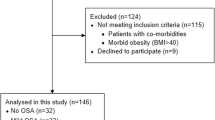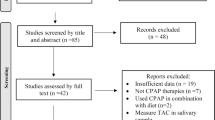Abstract
Objective
Several studies suggest that obstructive sleep apnea syndrome (OSAS) is associated with oxidative stress. However, there are also contrary observations and the role of antioxidant mechanisms has not been fully explored.
Patients and methods
The present study evaluated serum total antioxidant status (TAS) in 32 OSAS patients without comorbidities, before and after a diagnostic sleep study and at a second sleep study after continuous positive airway pressure (CPAP) application.
Results
Lower TAS values were found in the morning, immediately after the first sleep study, compared with those before sleep (1.68 ± 0.11 vs. 1.61 ± 0.10 mmol/l, p < 0.01); this was evident in patients with less severe syndrome [apnea–hypopnea index (AHI) <30; 1.73 ± 0.08 vs. 1.65 ± 0.09 mmol/l, p = 0.01] but not in severe syndrome (AHI ≥30; 1.64 ± 0.12 vs. 1.58 ± 0.10 mmol/l, p = 0.07). After CPAP application, a statistically significant decrease in TAS values was observed in patients with less severe syndrome (1.72 ± 0.05 vs. 1.63 ± 0.04 mmol/l, p = 0.003). On the contrary, no statistically significant changes in TAS were observed in patients with severe syndrome.
Conclusions
The present study supports a reduction in antioxidant capacity during sleep in otherwise healthy patients with OSAS. This reduction was evident in less severe syndrome. However, a single night of CPAP application seems to ameliorate this antioxidant disturbance only in less severe syndrome.

Similar content being viewed by others
Abbreviations
- OSAS:
-
Obstructive sleep apnea syndrome
- CPAP:
-
Continuous positive airway pressure
- TAS:
-
Total antioxidant status
- PSG:
-
Polysomnography
- BMI:
-
Body mass index
- AHI:
-
Apnea–hypopnea index
References
McCord MJ (1985) Oxygen derived free radicals in post ischemic tissue injury. New Engl J Med 312:159–163
Douglas NJ, Polo O (1994) Pathogenesis of sleep apnoea/hypopnoea syndrome. Lancet 344:653–655
Bast A, Haenen GRMM, Doelman CJA (1991) Oxidants and antioxidants: state of the art. Am J Med 91(3C):2S–12S
Haliwell B, Gutteridge JMC (1998) Detection of free radicals and other reactive species: trapping and fingerprinting. In: Haliwell B, Gutteridge JMC (eds) Free radicals in biology and medicine, 3rd edn. Oxford University Press, Oxford, pp 351–429
Schulz R, Mahmoudi S, Hattar K, Sibelius U, Olschewski H, Mayer K, Seeger W, Grimminger F (2000) Enhanced release of superoxide from polymorphonuclear neutrophils in obstructive sleep apnea: impact of continuous positive airway pressure therapy. Am J Respir Crit Care Med 162:566–570
Dyugovskaya L, Lavie P, Lavie L (2002) Increased adhesion molecules expression and production of reactive oxygen species in leukocytes of sleep apnea patients. Am J Respir Crit Care Med 165:934–939
Christou K, Kostikas K, Pastaka C, Tanou K, Antoniadou I, Gourgoulianis KI (2009) Nasal continuous positive airway pressure treatment reduces systemic oxidative stress in patients with severe obstructive sleep apnea syndrome. Sleep Med 10(1):87–94
Barcelo A, Miralles C, Barbe F, Vila M, Pons S, Agusti AGN (2000) Abnormal lipid peroxidation in patients with sleep apnoea. Eur Respir J 16:644–647
Lavie L, Vishnevsky A, Lavie P (2004) Evidence for lipid peroxidation in obstructive sleep apnea. Sleep 27:123–128
Ozturk L, Mansour B, Yuksel M, Yalcin AS, Celikoglou F, Gokhan N (2003) Lipid peroxidation and osmotic fragility of red blood cells in sleep-apnea patients. Clin Chim Acta 332:83–88
Svatikova A, Wolk R, Lerman LO, Juncos LA, Greene EL, McConnell JP, Somers VK (2005) Oxidative stress in obstructive sleep apnoea. Eur Heart J 26:2435–2439
Wali SO, Bahammam AS, Massaeli H, Pierce GN, Iliskovic N, Singal PK, Kryger MH (1998) Susceptibility of LDL to oxidative stress in obstructive sleep-apnea. Sleep 21:290–296
Alzoghaibi MA, Bahammam AS (2005) Lipid peroxides, superoxide dismutase and circulating IL-8 and GCP-2 in patients with severe obstructive sleep apnea: a pilot study. Sleep Breath 9:119–126
Rechtschaffen A, Kales A (eds) (1968) A manual of standardized terminology, techniques, and scoring system for sleep stages of human subjects. US Department of Health, Education, and Welfare Public Health Service—NIH/NIND
(1999) Sleep-related breathing disorders in adults: recommendations for syndrome definition and measurement techniques in clinical research. The report of an American Academy of Sleep Medicine Task Force. Sleep 22:667–689
The Atlas Task Force (1992) EEG arousals: scoring rules and examples; a preliminary report from the sleep disorders Task Force of the American Sleep Disorders Association. Sleep 15:173–184
Svatikova A, Wolk R, Wang HH, Otto ME, Bybee KA, Singh RJ, Somers VK (2004) Circulating free nitrotyrosine in obstructive sleep apnea. Am J Physiol Regul Integr Comp Physiol 287:284–287
Christou K, Moulas AN, Pastaka C, Gourgoulianis KI (2003) Antioxidant capacity in obstructive sleep apnea patients. Sleep Med 4:225–228
Barcelo A, Barbe F, de la Pena M, Vila M, Perez G, Pierola J, Duran J, Agusti AGN (2006) Antioxidant status in patients with sleep apnoea and impact of continuous positive airway treatment. Eur Respir J 27:756–760
Conflict of interest
All authors declare that they have no conflict of interest and have received no financial or other support or benefit from any source regarding the present study.
Author information
Authors and Affiliations
Corresponding author
Rights and permissions
About this article
Cite this article
Katsoulis, K., Kontakiotis, T., Spanogiannis, D. et al. Total antioxidant status in patients with obstructive sleep apnea without comorbidities: the role of the severity of the disease. Sleep Breath 15, 861–866 (2011). https://doi.org/10.1007/s11325-010-0456-y
Received:
Revised:
Accepted:
Published:
Issue Date:
DOI: https://doi.org/10.1007/s11325-010-0456-y




